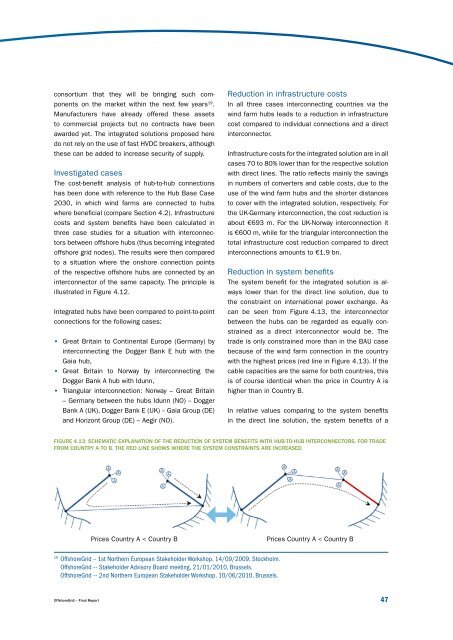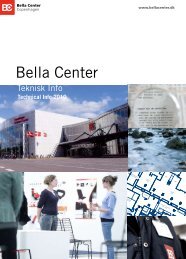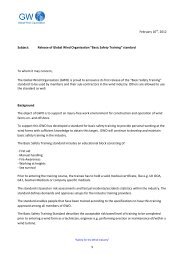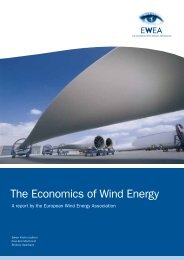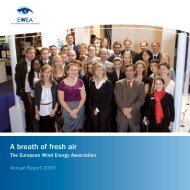Offshore Electricity Infrastructure in Europe - European Wind Energy ...
Offshore Electricity Infrastructure in Europe - European Wind Energy ...
Offshore Electricity Infrastructure in Europe - European Wind Energy ...
Create successful ePaper yourself
Turn your PDF publications into a flip-book with our unique Google optimized e-Paper software.
consortium that they will be br<strong>in</strong>g<strong>in</strong>g such components<br />
on the market with<strong>in</strong> the next few years 19 .<br />
Manufacturers have already offered these assets<br />
to commercial projects but no contracts have been<br />
awarded yet. The <strong>in</strong>tegrated solutions proposed here<br />
do not rely on the use of fast HVDC breakers, although<br />
these can be added to <strong>in</strong>crease security of supply.<br />
Investigated cases<br />
The cost-benefit analysis of hub-to-hub connections<br />
has been done with reference to the Hub Base Case<br />
2030, <strong>in</strong> which w<strong>in</strong>d farms are connected to hubs<br />
where beneficial (compare Section 4.2). <strong>Infrastructure</strong><br />
costs and system benefits have been calculated <strong>in</strong><br />
three case studies for a situation with <strong>in</strong>terconnectors<br />
between offshore hubs (thus becom<strong>in</strong>g <strong>in</strong>tegrated<br />
offshore grid nodes). The results were then compared<br />
to a situation where the onshore connection po<strong>in</strong>ts<br />
of the respective offshore hubs are connected by an<br />
<strong>in</strong>terconnector of the same capacity. The pr<strong>in</strong>ciple is<br />
illustrated <strong>in</strong> Figure 4.12.<br />
Integrated hubs have been compared to po<strong>in</strong>t-to-po<strong>in</strong>t<br />
connections for the follow<strong>in</strong>g cases:<br />
• Great Brita<strong>in</strong> to Cont<strong>in</strong>ental <strong>Europe</strong> (Germany) by<br />
<strong>in</strong>terconnect<strong>in</strong>g the Dogger Bank E hub with the<br />
Gaia hub,<br />
• Great Brita<strong>in</strong> to Norway by <strong>in</strong>terconnect<strong>in</strong>g the<br />
Dogger Bank A hub with Idunn,<br />
• Triangular <strong>in</strong>terconnection: Norway – Great Brita<strong>in</strong><br />
– Germany between the hubs Idunn (NO) -- Dogger<br />
Bank A (UK), Dogger Bank E (UK) -- Gaia Group (DE)<br />
and Horizont Group (DE) – Aegir (NO).<br />
19 <strong>Offshore</strong>Grid – 1st Northern <strong>Europe</strong>an Stakeholder Workshop, 14/09/2009, Stockholm.<br />
<strong>Offshore</strong>Grid -- Stakeholder Advisory Board meet<strong>in</strong>g, 21/01/2010, Brussels.<br />
<strong>Offshore</strong>Grid -- 2nd Northern <strong>Europe</strong>an Stakeholder Workshop, 10/06/2010, Brussels.<br />
<strong>Offshore</strong>Grid – F<strong>in</strong>al Report<br />
Reduction <strong>in</strong> <strong>in</strong>frastructure costs<br />
In all three cases <strong>in</strong>terconnect<strong>in</strong>g countries via the<br />
w<strong>in</strong>d farm hubs leads to a reduction <strong>in</strong> <strong>in</strong>frastructure<br />
cost compared to <strong>in</strong>dividual connections and a direct<br />
<strong>in</strong>terconnector.<br />
<strong>Infrastructure</strong> costs for the <strong>in</strong>tegrated solution are <strong>in</strong> all<br />
cases 70 to 80% lower than for the respective solution<br />
with direct l<strong>in</strong>es. The ratio reflects ma<strong>in</strong>ly the sav<strong>in</strong>gs<br />
<strong>in</strong> numbers of converters and cable costs, due to the<br />
use of the w<strong>in</strong>d farm hubs and the shorter distances<br />
to cover with the <strong>in</strong>tegrated solution, respectively. For<br />
the UK-Germany <strong>in</strong>terconnection, the cost reduction is<br />
about €693 m. For the UK-Norway <strong>in</strong>terconnection it<br />
is €600 m, while for the triangular <strong>in</strong>terconnection the<br />
total <strong>in</strong>frastructure cost reduction compared to direct<br />
<strong>in</strong>terconnections amounts to €1.9 bn.<br />
Reduction <strong>in</strong> system benefits<br />
The system benefit for the <strong>in</strong>tegrated solution is always<br />
lower than for the direct l<strong>in</strong>e solution, due to<br />
the constra<strong>in</strong>t on <strong>in</strong>ternational power exchange. As<br />
can be seen from Figure 4.13, the <strong>in</strong>terconnector<br />
between the hubs can be regarded as equally constra<strong>in</strong>ed<br />
as a direct <strong>in</strong>terconnector would be. The<br />
trade is only constra<strong>in</strong>ed more than <strong>in</strong> the BAU case<br />
because of the w<strong>in</strong>d farm connection <strong>in</strong> the country<br />
with the highest prices (red l<strong>in</strong>e <strong>in</strong> Figure 4.13). If the<br />
cable capacities are the same for both countries, this<br />
is of course identical when the price <strong>in</strong> Country A is<br />
higher than <strong>in</strong> Country B.<br />
In relative values compar<strong>in</strong>g to the system benefits<br />
<strong>in</strong> the direct l<strong>in</strong>e solution, the system benefits of a<br />
FIGURE 4.13: SchEMATIc EXPlANATION OF ThE REdUcTION OF SYSTEM bENEFITS WITh hUb-TO-hUb INTERcONNEcTORS, FOR TRAdE<br />
FROM cOUNTRY A TO b. ThE REd lINE ShOWS WhERE ThE SYSTEM cONSTRAINTS ARE INcREASEd<br />
Prices Country A < Country B Prices Country A < Country B<br />
47


